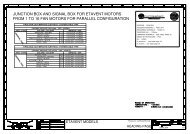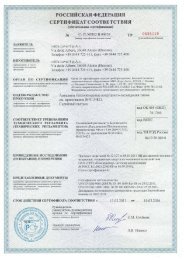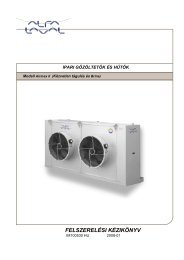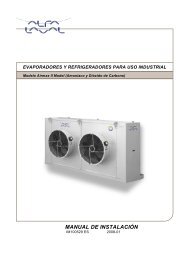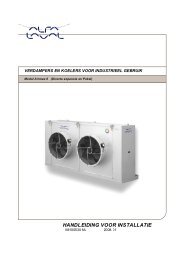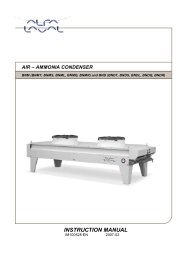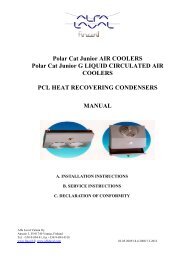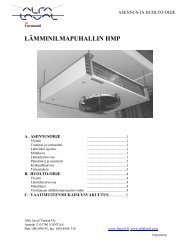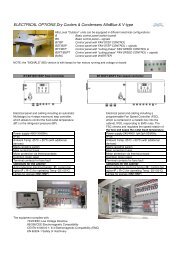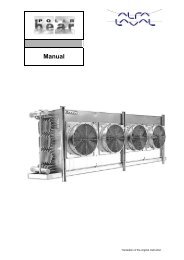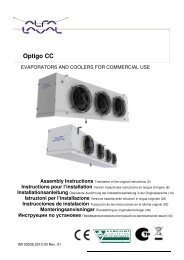MANUAL SCAL, SCCL, SEpL AIR COOLED ... - Alfa Laval - ABC
MANUAL SCAL, SCCL, SEpL AIR COOLED ... - Alfa Laval - ABC
MANUAL SCAL, SCCL, SEpL AIR COOLED ... - Alfa Laval - ABC
You also want an ePaper? Increase the reach of your titles
YUMPU automatically turns print PDFs into web optimized ePapers that Google loves.
2 TRANSPORT AND STORAGE2.1 PACKING, CONTENTS AND HANDLING OF PACKAGESolar range air cooled condensers and dry coolers are transported in an upright or horizontal position on awooden flat.Both in upright and horizontal transport position the unit withvertical air flow is from its legs fixed into the wooden flat, legsinstalled in transport position. Lifting /turning lug, turning legand horizontal leg support are delivered loose in the samepackage. Lifting/turning lug and turning leg are included inthe package of the models packed in an upright position only.The unit with horizontal air flow, packed in an uprightposition, is fixed into the wooden flat from a mounting rail.The lifting lug is delivered loose in the same package.When lifting the package by forklift truck, please use thelifting point where the lengthwise centre of gravity is betweenthe forklifts, in the middle. When lifting a long unit, pleaseuse as wide lifting position as possible.Fig. 2.1 On the left: the unit packed in anupside positionOn the right: the unit packed in horizontalpositionNOTE !Be very careful when handling high units. Never place them on inclined or uneven plane due toDANGER OF FALLING!Please check that the unit is tied tightly enough to prevent moving during transport. Take care that theunit is not damaged through binding.2.2 STORAGEThe products may not be stored in humid outdoor spaces, where water may condensate in their fan motors orin the tubing of heat transfer section. The motor bearings may be damaged by the humidity. Long standinghumidity in the tubing of heat transfer section can cause formic acid corrosion . The units shall be stored indry spaces with even temperature. During long term storage the fan motors must be driven for at least 30minutes once a month.If the above mentioned storage conditions cannot be guaranteed, a continuous low voltage must be lead intothe motors to keep their surface temperature higher than the air dew point temperature.In humid conditions, where the unit will not keep dry, some “white rust” can exist on the zink surface.The units shall be stored fixed on their packing flats.Do not keep the units stored on inclined or uneven plane.4
2.3 TURNING AND LIFTING THE UNITNOTE !The unit may be lifted by an experienced operator only, who is familiar with theregulations and safety instructions concerning liftings.Before starting the lifting please make sure that:• manual is included• necessary advance control has been made• lifting device has been checked and is functioning well• driver has the permission for lifting• ground under the unit has enough bearing capacity• machine/device is correctly erected and horizontally installed• support legs are in supporting position• lifting capacity of the device is sufficient• operators know, how to use the lifting device according to operation and safety instructions• there are no electric or other cables near to the lifting place• working area of the lifting device is sufficient and safe• there are no obstacles or risks on the working areaHow to turn a unit with vertical air flow, packed in an upright position, into operatingposition:• Fix the lifting /turning lugs (included in the delivery) into the fixing points on unit sides. Make surethat the lugs are tightly fixed!• Hang the unit by crane from the lifting/turning lugs so that the lifting chain is tightening but the unitstill stands on ground.• Remove the unit from the transport flat.• Lift up the unit ca 0,5 m from the ground. Install the turning legs (included in the delivery) so thatthe leg is ca 0,5 m outwards from the lower side of the unit. Fix the turning leg by screws into theside of the fan plate and of the unit leg being in transport position (see Fig 2.2). While fixing thelegs, support the unit so that it does not swing or fall down.WARNING! Do not stay under the unit being hanged!• Put down the unit carefully so that the unit turns around the turning leg, to the direction of the centreof gravity. The crane is driven into the turning position and slowly put down into horizontal position.• Remove the lifting/turning (for horizontal model) from the unit.• Remove the turning legs.• Hang the unit using the lifting points of the model with vertical air flow. Install the legs of thevertical model into right installation height.NOTE !The unit may be lifted by using the designed lifting points only.For lifting and turning a model with horizontal air flow only appropriate lifting/turning lugs may be used(fig. 2.2.1).For liftingf a model with vertical air flow only the lifting lugs designed for this purpose may be used (Fig.2.2.4).When lifting the unit, all lifting points in the direction of lifting shall be used.The allowed angles for lifting device may not be exceeded.When lifting long units, a lifting beam shall be used.5
1. 2.3.4. 5.max. 60 oAmax. 60 oFigure 2.2.1…2.2.5 Turning and lifting of the unitNOTE ! The minimum length of a lifting chain, when no lifting channel is used =distance of lifting points.Distance Distance Distance<strong>SCAL</strong> between Unit <strong>SCAL</strong> between Unit <strong>SCAL</strong> between UnitSCAG lifting points weight SCAG lifting points weight SCAG lifting points weightA [mm] kg A [mm] kg A [mm] kg111 1400 240 152 4200 1300 253 6300 2770112 1400 260 153 5400 1600 261 7200 2730113 1800 320 221 3600 920 262 7200 2970121 2800 480 222 3600 990 263 8400 3320122 2800 520 223 4200 1110 264 7200 3200123 3600 640 231 1800 1370 265 7200 3430131 1400 720 232 1800 1490 266 8400 3590132 1400 780 233 2100 1670 267 8400 3860133 1800 960 241 3600 1830 271 5400 3190141 2800 960 242 3600 1980 272 5400 3460142 2800 1040 243 4200 2220 273 5400 3730143 3600 1280 251 5400 2280 274 5400 4000151 4200 1200 252 5400 2470 - - -Table 2.1 : Distance between lifting points. It is recommended to use a lifting channel.Non-standard models (E) and copper coil (CC): check the unit weight from the product nameplate!2.4 DISCHARGE AND RECYCLING OF PACKING MATERIALSAll packing materials are suitable eitherfor recycling or for energy recovery.6
3 INSTALLATION INSTRUCTIONS3.1 PLACINGAir cooled condensers and dry coolers should be situated so that there is no obstruction to air flow and thatno hot air recirculation will occur.When choosing the installation site, please note, that the air flow from the units should be away from windblowing against it. This concerns especially the models with horizontal air flow and with low rpm fans.When necessary, please use fairings.In dimensioning, the actual site temperature in the sun should be noticed. Please also note the effect of snowfor the installation level of the unit.Placing of a unit with horizontal air flow> B/2> BBB> B/2> 2 x BBB> BBB> B/2> B/2Fig.3.1 Placing of a unit with horizontal air flow7
Effect of wind direction> 2 x BB >BPlacing of a unit with vertical air flow> B> B / 2B > A / 4B> B / 2> A / 4 BAAFig. 3.3 Fans in one row, the wall higher than theunit heightFig. 3.4 Fans in two rows, the wall higherthan the unit heightTwo units with fans in one row ( B = 1630 mm ) can be installed side by side (please note the minimumdistances shown in fig. 3.3). The leg height should be checked – when necessary, the units should beinstalled on a platform.If the wall is lower than the unit, the minimum distance between the unit and the wall is 0.5 x the minimumdistance with a higher wall.If the units are surrounded by 3 or 4 walls, the minimum distances are longer and should be checkedaccording to amount of units and their air flow.In exceptional cases please contact the product supplier/manufacturer!8
3.2 INSTALLATION REMARKS• Before installation please check at site possible transport damages, especially those in heat transfersection. The supplier is not responsible for costs caused by equipment broken as result of faultyhandling.• Check the bearing capacity of fixing points and support structures before installation (see the unitweights in product leaflets!).• To ensure optimum oil circulation of the condensers, and air venting and drainage of the dry coolers,the tubes of the heat transfer section should be in horizontal position.• Trouble-free operation of the dry coolers provides good air venting of the units. Use the ventingscrews on the headers for air venting of the heat transfer section. Please always follow theinstructions of the refrigerant supplier!• Water circulated dry coolers shall be drained, when the ambient temperature is < 0 °C. Standard drycoolers are not gravity drained. It is recommended to use frost-proof refrigerants in installations,where the ambient temperature can be lower than 0 °C.• Please always follow the instructions of the refrigerant supplier in installation, in performing thepressure test, in taking into use, operation and service.• All soldering of the heat transfer section is made by hard solder (FOSCO 710/DIN8513/LAg2P).3.3 SET-UP FOR INSTALLATIONThe models with horizontal air flow can be installed directly to the installation site. Just remove the liftinglugs after lifting.When mounting a unit with vertical air flow, the legs are installed in correct height. If the unit is installeddirectly on a plane surface should the height of the legs from the surface to the lower edge of the unit be ca620 mm (see figure!). Please also install the legs´ horizontal supports (see fig. 3, 5).When the unit is installed on a basement, the legs can be installed in steady middle position (ca 420 mm),without any horizontal support (fig. 3.6).Horizontalsupport for legs~420~620Fig. 3.5 Installation with legs directlyFig. 3.6 Installation on basement3.4 TUBE CONNECTIONSThe external tubes shall be installed in a way that their weight, vibration or heat expansion will notstrain the tubes of the heat transfer section.Condensers1:100The transmission of compressornoise and vibration to thecondenser can be eliminated bysufficient vibration dampers.Take care of correct charging andoil separation in the plant!9
1In multicircuited condensers the number of passesis given from left to right (vertical air flow), or fromup to down (horizontal air flow).2312Dry coolers3VentingFluid inVentingFluid outFluid inDischargeFluid outDischargeFigure 3.9 Model with vertical air flowFigure 3.10 Model with horizontal air flow3.5 FANS AND FAN CONNECTIONSNOTE !Electric connections may be performed by an authorized electrician only.The fans are direct driven axialfans. The fan motors are 3-phasesquirrel-cage motors built to theIEC standards, designed foroutdoor use and provided withcondensing water outlets, shaftseals and self-lubricating bearings.The motors are suitable for220...240 V/380...420 V 50Hzelectric network. Their protectionclass, except for condensing wateroutlet, is IP54. The motors areprewired to the safety switches(IP65).Please ask the condenser/dry coolermanufacturer about the technicaldata of the fan motors!Electric network 220...240V∆-connectionSafety switchMotor junctionboxYellow-greenBlueBlackElectric network 380...420VY-connectionBrownCoated w ithblack plastictubeFig. 3.11: Fans´ electrical connections: motor junction box andsafety switch10
3.6 FANS´ POWER VALUESThe product nameplate indicates the power values at +20º C and–30º C.For defining the set values of the overload protector, the powervalue at other temperatures might be required. It can be nearlylinearly calculated by using above mentioned points. Forexample, the power value corresponding to -10° C can becalculated by multiplying the power value corresponding to +20°C (from product nameplate) by coefficient (k) given in thediagram at–10° C.k1,21,0-30 -20 -10 0 10 20 30 40 °CFig. 3.12 : Motor power value depending ontemperature3.7 OPTIONSWater spraying system (D)The water spraying system helps to even out the shortloading peaks in summer time.For the unit with fans in one row one water spray tubingwill be installed. The units with fans in two rows will beequipped with two water spray tubings.The loose tubing together with assembly instructions will bedelivered with the unit.Please assemble the tubing in numerical order and at theplace shown in the figure below. Carefully tighten the jointsand make sure that all nozzles are in the same direction.Turn the tubing to get the nozzle angle to correspond the fanspeed. Check the right nozzle angle in the table at right!Lock the tubing at its place. The water flow is 0,5 l / min for one nozzle, pressure 3 bar.αααα1 Reduction joint 5 End tube2 Water nozzle 6 Distance tube3 T-connector 7 Plug + connector4 Double nipple 8 Clamp/ drill screwNOTE !The nozzles may be blocked up by limey water, which can also form an isolating layeron the surface of the heat transfer section.Wrong pH-value of water may damage the heat transfer section. The pH-value shallvary between 7...8.NOTE !The water tubing may be broken due to freezing water. The tubing shall always bedrained after use by opening end plug (no. 7).11
Stepwise (SC) and stepless (SVC) fan speedcontrolSVC fan speed control has been pre-configured andtest run at the factory including test-run of the fansand inspection of the regulator.See the leaflets of <strong>Alfa</strong> <strong>Laval</strong> Vantaa´s Step Control(SC) and SVC!The necessary documentation for the control systemis included in the delivery (within the terminal box).The cables corresponding to the EMC standard havebeen connected to the unit end. Please see thenormative cable lengths in the table 3.1! Thelengths might be different when using specialequipment or special cables.Vibration dampers (T)The suitability of the elastic vibration dampers,supplied by <strong>Alfa</strong> <strong>Laval</strong> Vantaa, has been ensured.• Check the load weight to be damped andmake sure that just the right dampers for thisload are available. Pay attention to theweight distribution of the damping rubber!• The vibration dampers are meant for vertical<strong>SCAL</strong>SCAGCableMCMK,[m]<strong>SCAL</strong>SCAGTable 3.1 Cable lenghtsThe cable lenghts of models [m]Fan size ø900 mmCableMCMK,[m]Fan size ø1200 mm<strong>SCAL</strong>SCAGCableMCMK,[m]111 4 221 19 221 9112 4 222 19 222 9113 4 223 20 223 10121 8 231 33 231 16122 8 232 33 232 16123 9 233 36 233 18131 14 241 53 241 26132 14 242 53 242 26133 17 243 57 243 28141 22 251 74 251 36142 22 252 74 252 36143 25 253 81 253 40151 30 261 98 261 48152 30 262 98 262 48153 36 263 107 263 54- - 264 98 264 48- - 265 98 265 48- - 266 107 266 54- - 267 107 267 54- - 271 127 271 63- - 272 127 272 63- - 273 127 273 63- - 274 127 274 63compression load. Check that the ground and the basement of the unit to be damped are horizontal.• When damping group of units, shall both the driving unit and the unit to be operated be placed on asimilar rigid basement.Vibration damper Deflection xx percentage from mm• Please check the ambient conditions at[mm]site:34 LV 10/_ _ 7,5...8 75...80% from 10 mmo Temperatures –35...+65°C 34 LV 16/_ _ 12...12,8 75...80% from 16 mm34 LV 24/_ _ 18...19,2 75...80% from 24 mmo Organic solvents are injurious 34 LV 40/_ _ 30...32 75...80% from 40 mmo Oils might damage the damper´srubber partsTable 3.2 Allowed deflection of the vibration damper• When connecting eg. tubes to the unit to be damped, always use flexible connections to guaranteetrouble-free vibration damping, to prevent transmission of vibration to the tubes and vibration stresson the tubing.• After installation please check the correct deflection of the dampers from the table 3.2.• Take care that there is margin around the unit to be damped.• Please ask the manufacturer for further instructions, when necessary.3.8. CHECKINGS BEFORE START-UPThe heat transfer section has been pressure-tested and the electric safety of the unit has been measured at thefactory. The electric safety checking includes steady-state and insulation resistance measurement of theprotecting cable. An introduction inspection has to be done before taking the unit into use, including bothsensory and visual checking and measurements.The customer has to make all measurements and tests (including grounding resistance measurement) whichare required in the operating country.Check visually:• Make sure that all components are in good condition, without any damage.• Make sure that the unit is firmly in position.12
• Check the fixing of mechanical parts.• Check the suitability of the electric network.• Check the electrical connections.• After electric installation, check that the fans rotate properly and that the air flow direction is correct.• When the fans are running please check that there is no unusual noise or vibration in the unit.• Make sure that there are all necessary connection diagrams, signs and warning stickers are included.Measurements on function:Steady-state measurement of the protecting cables (measurement is done, when the unit is in poweroffcondition. Earth potentials´ continuity resistance measurement is done between conductive partand nearest point which is connected on the main earth potential); there is no exact limit value forthe measurement, thus the measured value shall be compared with the value estimated on basis ofacross diameter and length of the cable.• Measurement of non-standard resistance (measurement is done, when the unit is in power-offcondition, in order to resolve that all the live parts (phases) are sufficiently insulated against earthpotential).- Make the unit dead.- Make sure that there is not any live equipment connected to the electric circuit.- Ensure that the unit is disconnected and dead.- Make sure that the switches of risers are closed and the fuses are placed.- If needed, loosen N-PE connection or neutral connector.- Perform the measurement. If the result is not acceptable, find out the reason.- Make the unit working again in reverse order.4 SERVICE INSTRUCTIONSNOTE !The electrical connections may be performed by an authorized electrician only.WARNING ! Before starting the service operations make sure that the unit iselectrically isolated and dead.4.1 SERVICE INSPECTIONTrouble-free operation of Solar range condensers and dry coolers provides regular service to check• visual condition of the units and fans, once a month• fixing of the units, fans, fan motors and fan guards, once a month• cleanness and visual condition of the heat transfer section, once a month• When the condenser/dry cooler capacity is stepwise controlled by changing the number of fans, therunning order of fans must be changed periodically.• correct deflection of vibration dampers, each year (when needed, replace the vibration dampers bynew ones supplied by <strong>Alfa</strong> <strong>Laval</strong> Vantaa Oy)4.2 HEAT TRANSFER SECTIONThe heat transfer section needs regular service if the unit is operated in dirty conditions. The dust gatheredon fins can be vacuum-cleaned (industrial vacuumcleaner)on air inlet side, or the fins can be washedwith water, preferably against the air flow.Washing can be done by running water, withoutusing pressure. Water must be directed onto the heattransfer section, against the air flow direction insidethe unit. The water jet may not be too strong, and itmust be directed perpendicularly to the fins´ side toprevent them bending or damaging Do not use anystrong alkaline detergents/solvents and acids, ordangerous, inflammable or environmentallydangerous detergents!The pH value of the washing water must be betweenFigure 4.1 Allowed angle of low pressure cleaningwater jet against the coil material13
7…8.WARNING ! Before washing the heat transfer section, read the Material Safety Data Sheetof the detergent and follow the manufacturer´s instructions!When vacum-cleaning and washing, use protection glasses, safety gloves, safety shoes andother personal protection!4.3 HEAT TRANSFER SECTIONPlease always check the motors, when performing service operations!Should the fan make any unusual noise, please stop it immediately, and check the fixing of the fan and fanmotor. When necessary, replace the motor by a new spare part motor supplied by <strong>Alfa</strong> <strong>Laval</strong> Vantaa.NOTE !During stand-stills the fans must be operated for 3…4 hours at least once a month.14
5 DISCARDS AND RECYCLINGWARNING ! Before discarding and demolishing the unit make sure that the unit is electrically isolatedand dead.5.1 RECOVERY OF REFRIGERANTSNOTE ! The refrigerant recovery of condensers may be performed by an authorized contractor only .The manufacturer´s instructions shall always be followed in handling and recovery of therefrigerants.NOTE !In demolishing the unit and in recovery, recycling and discarding of refrigerants,components and materials shall the local, national and international regulations befollowed.5.2 DEMOLISHING THE UNIT• Remove the unit from the installation site and transfer it to the place of demolishing. Please followthe instructions for lifting the unit.• Turn the unit with horizontal air flow into horizontal position by paying attention to the liftinginstructions.• Remove the fans, fan motors and cables.• Remove the fan plate, legs and side plates.• Remove the headers from the heat transfer section by cutting off the connection tubes.5.3 MATERIAL RECYCLING AND DISCHARGING• Sheet metals, Fe + Zn – to steel scrap• Heat transfer section, Cu-tube / Al--fin– to mixed copper scrap• Header, Cu – to copper scrap• Fan collar / motor bracket, Fe + Zn – to steel scrap• Fan guard, Fe + Zn to steel scrap• Motors recycling / scrapping (authorized contractor).• Safety switches, cables recycling / scrapping (authorized contractor)• Water jet tubing, Cu – to copper scrap6 ADDITIONAL REMARKSNOTE !Venting/draining valve of SCAG, SCCG, SEpG standard dry coolers is not adaptedfor heat transfer fluids based on potassium formiate; DANGER OF LEAKAGE!When using heat transfer fluids based on potassium formiate please always checkfrom the documentation that the piping system and venting/draining valves of theheat transfer section are adapted for the heat transfer fluid in question.Please follow the instructions of the heat transfer fluid supplier at installation,pressure-testing, starting-up, operation and maintenance.16
7 TROUBLESHOOTINGTrouble Reason What to doShort of capacity Refrigerant flow too low Check the valves/filters!Leakage in system / coil blockThe wrong flow direction in thecircuitingAir in systemFan/fans do not operate.Heat transfer section blocked up/dirtyIncoming air flow too lowWrong fan rotation directionInlet air too warmCheck the connections, brazings in heat transfersection and the tubing. When there is leakage inthe heat transfer section, please take contact withthe manufacturer for further repair instructions!See chapter 3.4 Tube ConnectionVentilate the system!Localize the problem, repair it or change the fanunit.Vacuum-clean/ wash the heat transfer sectionCheck the minimum distance between the unit andthe hinderances (see item 3.1 Location)Make sure that there are no obstacles for the airflow.Wrong phase sequence. Change the connection onmotor coupling or from the switch board.Check the location of the units (item 3.1). Shadethe unit from the sun! Heat transfer capacity can beincreased by water jet system.Vibration in the unit Broken fan Repair/ change the fan!Damaged vibration dampers Install new vibration dampers, check the correct…Fan does not start Fan is frozen in the fan collar Remove iceThe fuse has blown outReplace the fuseOverload releaseCheck and reset from the overload release switch!Wrong supply voltageWrong connectionCheck that the supply voltage corresponds to thevalue marked on the motor sign.Check the connections from the item ”Motorconnections” and from the product nameplate.Break in coil or in control circuitIf the switch is in off-position, there will bebumbling noise. Check the slack line switches!Check that the line switches close.Mechanical failureCheck that the fan motor and fan blade rotatefreely. Check the bearing and lubrication!Short circuit in coilCan be indicated by a blown-out fuse. The motorhas to be replaced.One phase in the motor can be Check the connection!broken.Fan stops. Voltage break Blown-out fusesLow voltageCheck that the voltage given the productnameplate is followed. Check the connections!17
Trouble Reason What to doFan starts, then stops Failure in supply voltage Check the loose connections, fuses and controlcircuit.Fan does not reach themaximum speedWrong fan motor typeToo low voltage at the fan motorterminals because of voltagedrop.Ask the supplier about a correct type of fan.Use higher voltage or a starter transformer. Checkthe connections and the correct cable size.Broken rotorCheck eventual breaks in short-circuiting ring.Generally, a new rotor or motor is neededMotor takes high amp. Too low voltage Check the size of cables on basis of voltage drop.Too low supply voltageCheck the supply voltageWrong rotation direction Wrong sequence of phases Change the connection on motor coupling or fromswitchboard..Fan motor overheating. Motor body or cooling openingsmay be dirty or blocked-up,Clean the motor and and ensure trouble-free aircirculation.therefore hindering proper motorventilation.One motor phase may be open. Check the connection.Earth faultIdentify and repairAsymmetric supply voltage to Check the cables and connections.motor terminalVibrating fan Loosen motor fixing Tighten the fixing screws and check the alignmentUnbalanced fan blade/Fan blades Balance the blade or change it.misalignedFaulty bearingsChange the bearings3-phase motor running as single Check the connectionsphaseToo big axial playCheck the bearingsAbrasive noise in fanFan blade is chafing against fancollar.Motor ventilator is chafingagainst the cover.Check the motor centering and fixing.Repair the fan/cover.Exceptionally heavy noiseof runningVentilator hits on insulation.Motor has got loose from itsfixing.Air gap not centralized.Prevent the touch.Tighten the fixing bolts and rebalance the fan.Check steering turning and bearings.NOTE !The motor may be discharged and assembled by a skilled mechanician only byusing proper tools and approach. The repair work shall be performedaccording to the standard IEC-60079-19.Under guarantee period the faulty motor must always be returned to thesupplier (do not demolish it!).Please always use the spare part motor supplied by <strong>Alfa</strong> <strong>Laval</strong> Vantaa toguarantee its applicability to operating conditions.18
8 ELECTRICAL SAFETY CHECKLISTAll service, maintenance, repair, controls and installation employees must have this list with them at everyjob and read through it before they start the job.These are the minimum requirements. If you cannot meet these requirements, you cannot start the work8.1 LOCKOUT AND TAGOUT1. Notify affected persons of the shut down.2. Shut down the equipment by the normal process.3. Disconnect and lock and tag all energy sources.4. Released any stored energy (capacitors, transformers, etc.).5. All employees working on the equipment must have theirown personal lock in placetulee olla oma lukitus asetettuna paikoilleen.6. Prior to servicing equipment a check must be made with a”proximate voltage sensor” to ensure that the frames orcontrol enclosures of equipment being serviced are notenergized.7. Check that circuit-testing devices are workingLockout/TagoutVerify with a testingdevice8. Verify the absence of electrical current or voltage with a circuit-testing device; use insulated glovesand an insulated mat.9. Notify affected persons of the return of electrical power.8.2 DIAGNOSING A PROBLEM WHERE POWER IS REQUIRED1. Remove all conductive clothing or accessories.2. Do not use any conductive equipment or tools.3. Use insulated tools and safety glasses4. Do Not work on electrical circuits greater than 600 voltsunless you have received specific training5. Suspend work or have a shelter during adverse weatherconditions.6. Use a certified insulated mat to stand on while doing thetesting.7. Use certified electrical insulated gloves while doing thetesting.8. After diagnostic work is completed and service work isrequired you must complete logout and tagout.UseinsulatedtoolsUseGFCI8.3 TOOLS AND EQUIPMENT (PPE)1. Ensure that electrical equipment you are working on isgrounded.2. Ensure that electrical power tools are double insulated orhave a ground plug.3. Use Ground Fault Circuit Interrupters (GFCI).4. Inspect power tools, insulated hand tools and electricalcords for damage5. Damaged tools and cords shall not be used.6. Do not use conductive equipment e.g. metal ladders.Wear PPE19
9 LIFTING INSTRUCTIONSThe Solar dry cooler and condenser units are transported in vertical position as standard.The units for horizontal installation (vertical air flow) must be turned at installation.Two turning supports with locking bolts (see pictures below) are included in the delivery ofthe Solar units .How to turn the unit:1. Lift the unit off the ground.2. Remove the transport pallet.3. Insert the turning support into the leg profile until it reaches the fitting bolts. Place the turning supportbeneath both lifting eyes.4. Lock the turning support into the leg with a locking bolt.Turning the unitTurning supports (remove locking bolts before installation!)Turning supports placed correctly20
LIFTING INSTRUCTIONSAir cooled heat exchangers are fragile products, which makes them extremely sensitive toincorrect handling during transport and positioning. The instructions given must be strictlycomplied with in order to prevent the heat exchanger from being damaged during the liftingprocedure.Lifting operations must at all times be carried by qualified personnel using approved liftingequipment.21
DECLARATION BY THE MANUFACTURER OF THE COMPONENTINCORPORATED TO THE MACHINERY (DIRECTIVE 2006/42/EC, ANNEXII, SUB.B)ALFA LAVAL VANTAA OYAnsatie 3, FI-01740 Vantaa, Finlandherewith declares that the componentSJ, SCA, <strong>SCAL</strong>, <strong>SCCL</strong>, <strong>SEpL</strong>, SX air cooled condenserSJG, SCAG, SCCG, SEpG, SXG air cooled dry coolerwhich is not able to function independently is intended to be incorporated into machineryor to be assembled with other machinery to constitute machinery covered by Directive2006/42/EC and changes related to it and with national implementing legislation meantmachinery.By designing of the component the following directives have been applied:2006/42/EC, 2004/108/EC, 97/23/ECand the following harmonized standards have been applied:ISO 12100:2010, SFS-EN ISO 13857, SFS-EN 14276-2 + A1,SFS-EN 60204-1, SFS-EN 61000-6-1, SFS-EN 61000-6-3,SFS-EN 61000-6-4and furthermore declares that is not allowed to put the machinery into service until themachinery into which it is to be incorporated or of which it is to be a component has beenfound and declared to be in conformity with the provisions of Directive 2006/42/EC andwith national implementing legislation including the machinery referred to in thisdeclaration.Vantaa, May 21Silja BeierschoderQuality Manager22



